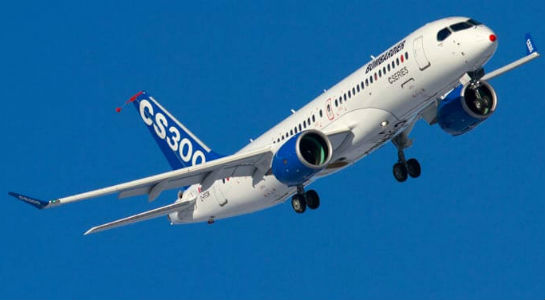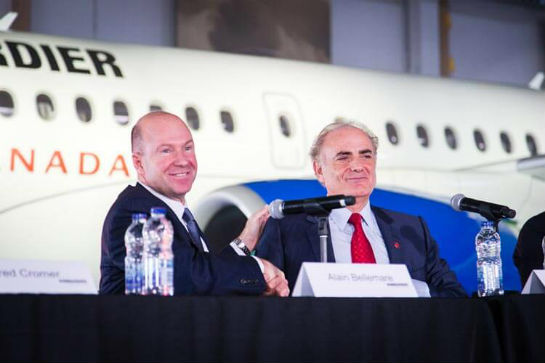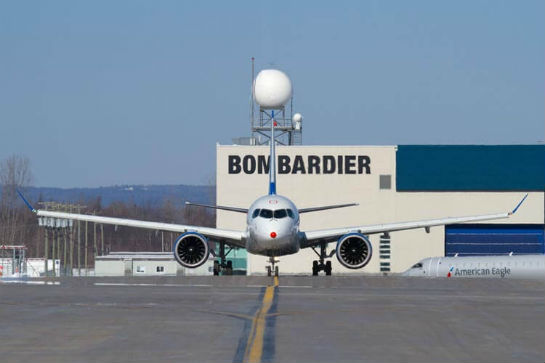According to AIAC president Jim Quick, Bombardier has launched 32 different aircraft programs over the past 30 years, invested $6.3 billion in research and development in the last 10 years, and patented 150 new inventions since 2010. Developments at Bombardier have a ripple effect throughout Quebec’s economy, for better or for worse. Andy Cline Photo
In late October, the Quebec government announced a $1.3 billion investment in Bombardier Aerospace’s C Series, the company’s highly touted medium-range jet that has been plagued by delays and cost overruns. In return, the provincial government acquired a 49.5 per cent minority stake in the program and reaffirmed its commitment to what it views as an essential industrial sector.
The federal government is now weighing the merits of a similar request from Bombardier for $1.3 billion to support the C Series through its first deliveries later this year and the ramp-up of aircraft production. With so many prominent cabinet members from Quebec, including the prime minister, it will be a difficult request to ignore.
Call it an investment, a subsidy, a bailout or corporate welfare—critics of the deal have used all of these terms and many more—such partnerships raise hard questions about the necessity of propping up a company or sector and the likely return. Is the taxpayer money an unnecessary lifeline, a prudent investment, or a lost cause? Does it signal confidence in the company or concern?
It’s not the first time Bombardier has received a subsidy from the federal government. Writing in The Globe and Mail, independent analyst Mark Milke calculated from access to information requests to Industry Canada that the Montreal-based company has received over $2.2 billion since 1966 and, if it “secures even more help from two levels of government this year, the total will be pushing $5 billion. And that assumes the company hasn’t received other disbursements from Quebec, other provinces, the federal government or other countries.”
However, many commentators have noted that aerospace is to Quebec what the automotive sector is to Ontario—a vital industry that needs to be supported and protected—and if $13.7 billion of federal and provincial dollars could be used in 2009 to subsidize the Chrysler Group and General Motors, then an investment in the Canadian-designed and built C Series is no less important.
“There is a lot of rationality to that,” said Peter Voss, president and CEO of Shimco, a precision parts manufacturer in Markham, Ont., which provides parts for every Bombardier commercial aircraft. “As much as people say there is a global market, you still see preference from the OEMs [original equipment manufacturers] and Tier 1 suppliers to buy as local as they can. [So] it does help the Canadian aerospace supply base having Bombardier here.”
Quebec would have a vibrant aerospace cluster with or without Bombardier, but with approximately 18,000 employees, “we are looking at several percentage points of Quebec’s employment,” said Karl Moore, associate professor at McGill University’s Desautels Faculty of Management. “And these are jobs that pay double the Quebec average—engineers and very skilled workers. They create lots of family incomes that are spent in Quebec.”
Air Canada’s Feb. 17, 2016, order for up to 75 C Series CS300 aircraft was welcome news for Bombardier, which has struggled to ink a deal for the new passenger jet with a major international carrier. Bombardier Image
Moore added that with CAE, Pratt & Whitney Canada, Bell Helicopter, Air Canada, Air Transat and organizations like the International Air Transport Association and International Civil Aviation Organization, Quebec is home to “a cluster that is fairly unique.” Toulouse, France, might have Airbus; Seattle, Washington, might have Boeing; and Sao Paolo, Brazil might have Embraer; but none has the extensive range of companies and governing bodies found in Montreal, he said.
And it’s a setup many other countries are trying to emulate.
“There are so many jurisdictions around the world that would like to have an aerospace industry,” said Suzanne Benoit, president of AeroMontreal, a think tank supporting the growth of the local sector. “And some of them are trying to build it from scratch. Governments are putting in a lot of money to attract investments in aerospace.”
Having an aircraft manufacturer at the heart of the sector is critical, said Jim Quick, president and CEO of the Aerospace Industries Association of Canada (AIAC). He noted that all four countries ranked ahead of Canada in aerospace have airliner manufacturers, whether it is Boeing or Airbus. “If you want to be a global leader in aerospace, then you need to have a leading manufacturer. And Bombardier is the third-largest manufacturer in the world.”
The presence of a leading manufacturer generates more than just jobs, Benoit observed. Along with other OEMs, Bombardier has helped attract over 200 small- and medium-sized enterprises (SMEs), including parts suppliers and repair and maintenance firms, fostered academic research, and supported university and technical college aerospace engineering and training programs, in what she called an intertwined ecosystem.
“This is all contributing to innovation and it is giving new graduates excellent jobs,” she said. “We keep our brain power here. Instead of losing it to Boeing or Airbus or other companies around the world, we have a Canadian company giving them challenges.”
A made-in-Canada deal: Alain Bellemare, president and CEO of Bombardier, left, shakes hands with Air Canada president and CEO, Calin Rovinsecu. Patrick Cardinal Photo
To illustrate the scope of Bombardier’s involvement in the sector, Benoit pointed to the MACH Initiative, a program developed and launched in 2011 by AeroMontreal to strengthen the supply chain structure in Quebec. Working with a larger manufacturer that acts as a mentor, small- and medium-sized suppliers receive help assessing their performance and developing strategies to improve, all of which are then audited. The intent is to improve supply chain competitiveness, business culture, collaboration and innovation, and identify strategies to help “fill existing integration gaps” in the supply chain.
The initiative, which began with 20 SMEs and now numbers 50, has been so successful that the federal government pledged to develop a national model in the 2015 budget by reallocating $6 million from the Strategic Aerospace and Defence Initiative.
In addition to working with a number of its suppliers in the program, Bombardier has provided the overall mentorship for the MACH Initiative. “We have had the support of many of their specialists in their supply chain to help us develop [it],” Benoit explained.
As a Quebec-based company with a global footprint, “Bombardier is a real flagship for Canada,” she added.
For Quick, Bombardier serves as an important incubator for innovation, both on its own and through its suppliers. He considers government investment in the C Series or any other aircraft program to be a necessary means of spurring the right research and development (R&D) climate.
He noted that Bombardier has launched 32 different aircraft programs over the past 30 years, invested $6.3 billion in R&D in the last 10 years, and patented 150 new inventions since 2010. “Their spending represents about 17.5 per cent of the total R&D spend of Canada’s top 100 R&D spenders,” said Quick.
Bombardier Business Aircraft restructured its business model in early 2016, with the goal of improving long-term profitability. Some of its third-party sales representative agreements have been terminated, with Bombardier opting to handle its own sales in certain regions. Galen Burrows Photo
“When I read news stories about corporate welfare and government handouts, [they overlook that] aerospace companies in Canada are making significant investments in the billions to produce new aircraft and products. The development of that technology, whether it be an aircraft or the technology that goes on it, takes 10 to 15 years in some cases. So, having government as an R&D investment partner is absolutely critical if we are going to be a global leader. And when we talk to government, it is imperative that we feel we are being well supported through R&D development and we get the right incentives from government to allow our companies to do R&D.”
The Bombardier effect is also central to export opportunities for its suppliers. Benoit described the recent transformation of the company’s supply chain management approach and what that has meant to Quebec-based companies. “Ten years ago many of our SMEs were very dependent on Bombardier because it was the only client they had,” she explained. “Now, they deal with the Tier 1 integrators who are the actual suppliers directly to Bombardier. It means they have to speak to companies in Germany, Italy, France, the U.S. It has forced them to internationalize themselves. It is a lot of work, but they minimize risk because they are not dependent on one client.”
Shimco’s relationship with Bombardier has been instrumental to its global success, Voss acknowledged. Like many SMEs, supplying components opened doors with global manufacturers that would have been far more difficult, time consuming and costly to access. “Since our products are on their approved supplier list, anytime Bombardier does a contract anywhere around the world, that company would then buy their products from us. We have ended up supplying all around the world to Bombardier Tier 1 and Tier 2 suppliers. For us, [the relationship] has a very, very big impact.”
If the C Series itself was once considered a risky gamble, an investment today could prove to be a savvy bet. With Transport Canada type certification on the CS100 now complete and entry into service with Swiss International Airlines, the launch customer, expected in the second quarter of this year, “a lot of the risk and a lot of the uncertainty is gone,” said McGill’s Karl Moore. Together with government investment and changes to Bombardier’s management team, “those are two big things which make a huge difference” to prospective buyers.
Alain Bellemare, Bombardier’s president and CEO, told an investor conference in November that while government support for the program has been “well received” by potential customers, it is not essential to the company’s bottom line. “Anything that would add to the benefit of the C Series and give it more traction in the marketplace would be a good thing,” he said, and that is why the company has continued to pursue government investment. “But from a cash standpoint, we are in good shape.”
In its 2015 year-end report, Bombardier said 2016 will be a year of transition. Its CS100 aircraft is scheduled to enter service with launch customer, Swiss International Air Lines, in the second quarter. Meanwhile, the larger CS300 is targeted to begin flying with airBaltic of Latvia some time in the second half of 2016. In mid-February, the OEM reported its CS300 certification program was more than 70 per cent complete. Andy Cline Photo
As of April 4, 2016, Ottawa had yet to make a decision about lending a hand to Bombardier. Innovation, Science and Economic Development Minister Navdeep Bains said the government was still reviewing the “business case” for the C Series investment. However, the company had received a letter of intent from Air Canada to acquire 45 C Series aircraft, with an option to buy 30 more, giving it a potential toehold with the country’s largest carrier.
Meanwhile, Bombardier has not only restructured its executive team, including appointing a chief of transformation, it has streamlined its procurement process, cancelled production of the Learjet 85, and reset production of its Global 5000 and 6000 business jets based on market forecasts. In February, it also signalled its intent to drastically reduce about 10 per cent of its 70,000-member global workforce over the next two years. The 7,000 job cuts would involve employees from its rail transportation, aerostructures and engineering services, aerospace product development and business aircraft units, and comes only a year after plans were announced to eliminate 2,400 jobs from the business jet program.
Meanwhile, Bombardier has not only transformed its executive team, including appointing a chief of transformation, it has streamlined its procurement process, cancelled production of the Learjet 85, and reset production of its Global 5000 and 6000 business jets based on market forecasts.
The C Series, the first completely new narrow-body airliner in over 30 years, is premised on market opportunity in the 100 to 150 seat segment, a gap between its well regarded regional jets and the larger aircraft of its competitors. Speaking at the Canadian Aerospace Summit in November, Ross Mitchell, Bombardier’s vice president of business acquisition for its commercial aircraft, noted that the average age of most fleets in that category is 50 years. “It is prime for replacement,” he said. “We expect 7,000 deliveries in the next 20 years in that market, and we are the only airframer who is bringing forward a new airplane to the market,” which he pegged at about $460 billion over the 20 years.
Fred Cromer, president of commercial aircraft, told the investor conference that Bombardier expects to capture 50 per cent of that market share, or 3,500 deliveries. “No other airplane is optimized to service” that market, he said.
Integrating lighter and more advanced technologies into the airframe, Cromer said the C Series can “offer not only lower trip costs, but equivalent or better seat mile costs” compared to rivals such as the Airbus A320 or the Boeing 737 MAX. “Being able to have a unit cost that is similar, with a much lower risk level, that is the proposition behind the airplane,” Mitchell added.
When the management team spoke in November, firm orders for the C Series stood at 243, though letters of interest and options pushed that closer to 600. But Cromer anticipated that many potential customers were taking a wait-and-see approach to confirm Bombardier’s ability to actually “deliver on what it has promised.” Would a federal government stake in the aircraft help boost buyer confidence? Is it a necessary investment? For suppliers and the organizations supporting the sector, especially in Quebec, the answer is pretty clear.









